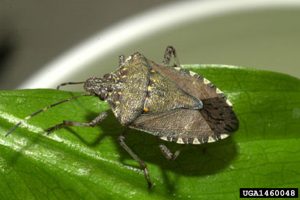A global pest risk assessment for the brown marmorated stink bug
Codename: “Project Stinky”

Objectives
- Produce pest risk models and maps that assess the global threat posed by the brown marmorated stink bug, Halyomorpha halys (Stäl) (Hemiptera: Pentatomidae), to agriculture, natural resources, and human welfare.
- Provide detailed examples to illustrate how thinking and modelling about pest invasion, specifically pest entry, establishment, spread, and impact, evolve as new information becomes available.
- Share insights about the modelling and mapping process with new pest risk analysts.
- Deliver map products and training opportunities based on brown marmorated stink bug to developing nations and others.
Rationale
This project is intended to focus the skills and talents of the International Pest Risk Research Group (IPRRG) on a pressing global issue and to demonstrate the value of the Group to scientists, managers, and policy makers with interests in biosecurity and pest invasions. As stated in the Group’s constitution, “The International Pest Risk Research Group is a dedicated group of research scientists and pest risk practitioners who aim to develop enhanced pest risk modelling and mapping methods through rigorous and innovative research focused on the key challenges faced by the discipline. We also provide technical training in the methods utilized to generate these outputs, thereby promoting best practice in their application.”
Project Stinky addresses three needs that IPPRG identified (BioScience. 2010. 60(5):349-362) to improve pest risk models and maps:
- The need for international collaboration;
- The need to work towards impact assessment;
- The need for additional training in the practice of pest risk modelling and mapping.
The brown marmorated stink bug is native to Asia. It was first detected in the USA in 1996, though not recognized until 2001, and in Switzerland in 2007. The insect now also occurs in Canada, Abkhazia, Austria, Bulgaria, France, Georgia, Germany, Greece, Hungary, Italy, Liechtenstein, Romania, Russia, Serbia and Spain. Brown marmorated stink bug has more than 100 host species, several of which are woody ornamentals or horticultural crops. Economic damage, particularly on fruit crops, can be severe. Initial species distribution models suggest areas of moderate to high climate suitability occur in most continents (except Antarctica). This insect could be globally significant.
Leadership and participation
All members of the IPRRG are welcome to contribute. The overall effort is being coordinated by Rob Venette (USA; email: rvenette “AT” fs.fed.us). Teams to develop models for components of the invasion process are being led by:
- Dan Borchert (USA; email: Daniel.M.Borchert “AT” aphis.usda.gov) pest entry
- Sue Worner (New Zealand; email: Susan.Worner “AT” lincoln.ac.nz) establishment
- Gericke Cook (USA; email: Gericke.L.Cook “AT” aphis.usda.gov) spread
- Darren Kriticos (Australia; email: Darren.Kriticos “AT” csiro.au) impact
Interested in participating, but not yet a member of IPPRG? Please register and join us today!
Resources
A Google Drive (IPRRG_Project_Stinky) has been created to store useful literature, data sets, and interim products. Darren Kriticos administers the Drive and is willing to provide access upon request. There are also online discussion forums (accessible by logged-in IPRRG members) for each team and the overall project.
Timeline
Project Stinky was self-selected by IPRRG. It was not assigned by any member organization, and thus, is not the primary assignment of any individual. The generous timeline is designed to accommodate the already-full schedules of our contributors. All progress is to be reported at annual meetings of IPRRG:
- 2016 Draft models presented to the group. Receive initial reviews and comments.
- 2017 Models of entry, establishment, spread, and impact completed. Work begins to integrate component models.
- 2018 Results are integrated into training exercises for pest risk modelling and mapping.
To learn more about Project Stinky, contact Rob Venette or one of the team leaders.
